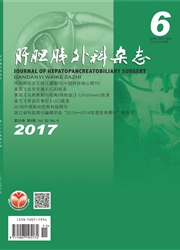

 中文摘要:
中文摘要:
目的通过建立梗阻性黄疸动物模型,在蛋白水平观察多耐药相关蛋白MRP3(multidrug resistanceassociated protein3,MRP3)和核受体Lrh-1(liver receptor homologue-1)表达变化并分析二者之间的关系。方法胆总管结扎术法制备大鼠梗阻性黄疸模型.检测肝功能:提取大鼠肝细胞膜蛋白与核蛋白.测定提取液蛋白浓度;采用Western blot技术检测MRP3和Lrh-1蛋白表达。结果梗阻性黄疸大鼠总胆红素、直接胆红素显著升高,白蛋白显著降低;与假手术对照组相比,梗阻性黄疸组大鼠肝细胞MRP3和Lrh-1蛋白表达明显升高俨值分别为0.027和0.046),差异有统计学意义。结论MRP3表达上调可能与Lrh-1激活有关。Lrh-1蛋白可能对MRP3蛋白表达有正性调控作用。
 英文摘要:
英文摘要:
Objective To investigate the relationship between membrane protein MRP3 (muhidrug resistanceassociated protein 3) and nuclear receptor Lrh-1 (liver receptor homologue-1) in bile duct ligated (BDL) rat liver. Methods Physiological and biochemical parameters of the blood were determined to detect liver function. Membrane protein and nuclear protein were isolated from the liver tissue of BDL rats. The protein expressions of MRP3 and Lrh-1 were determined with Western blotting. Results Total bilirnbin (TB) and direct bilirubin (DB) increased, but albumin (ALB) decreased. In BDL rat liver, the membrane protein MRP3 and Lrh-1 expression were all significantly up-regulated. Conclusion The up-regulation of hepatic membrane protein MRP3 may be associated with up-regulation of nuclear receptor Lrh-1. There may be positive correlation between them.
 同期刊论文项目
同期刊论文项目
 同项目期刊论文
同项目期刊论文
 期刊信息
期刊信息
